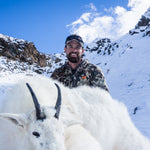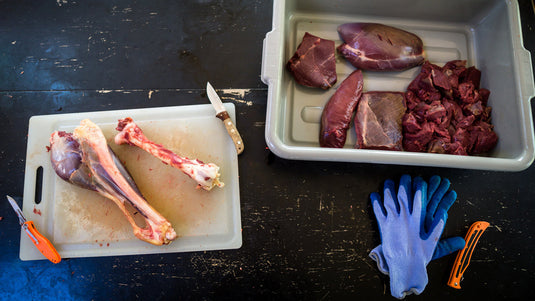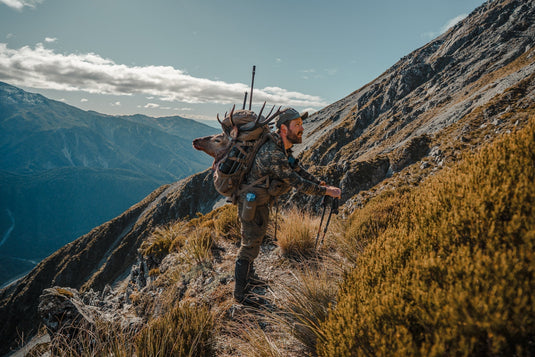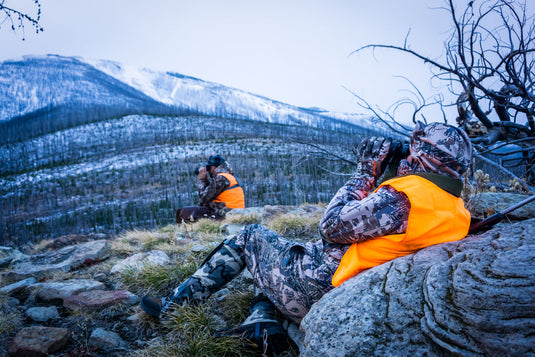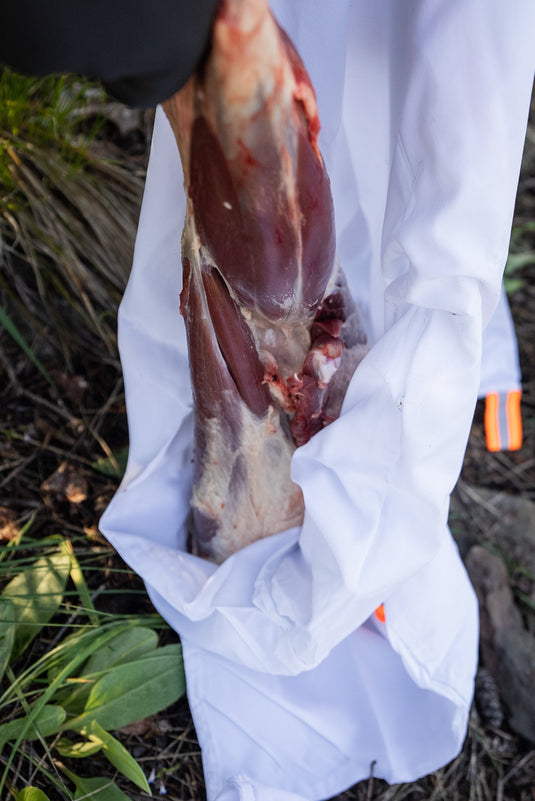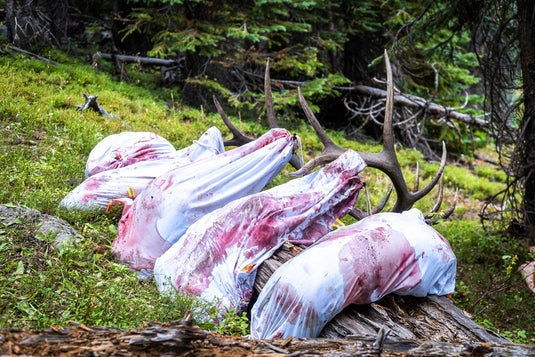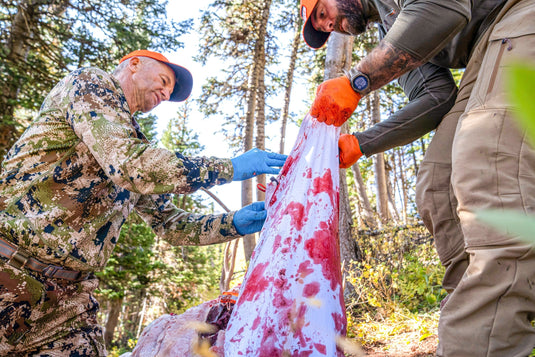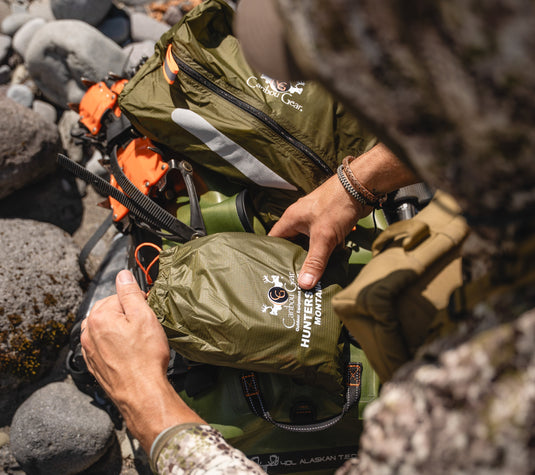If you're planning a western big game hunt this year, it's time to study the options. Some hunters will be looking at limited license opportunities. Others might consider over-the-counter (OTC) options. For many of us, our hunting season will include a combination of limited tags and OTC hunts.
No matter which boat you’re in, it’s time to do our homework. Whether you’re trying to decide where to apply for limited licenses, or sorting through the OTC options, there’s a great deal of planning to be done.
For more ideas on planning hunts and applications for the upcoming season, see our previous article on that subject. In this article, we're going to tackle some strategies for e-scouting.
Fortunately, scouting from home has never been easier. With resources like those from GoHunt, OnX Hunt maps and Google Earth, we can find new areas to hunt and learn a lot about those spots before ever leaving home.
Of course, nothing replaces boots on the ground experience. Inevitably, there are things you’ll learn when you arrive in an area that you wouldn’t have known otherwise. However, a good e-scouting plan can get you most of the way there – and way ahead of the curve.
THE RESOURCESBefore we get into the strategies for e-scouting, it's worth explaining the resources we like to use when planning a western big game hunt. This is not an exhaustive list. There are many more tools and systems available. Everyone has their favorites and we get that. Our advice is to try as many as you can and find a system that works for you. These just happen to be some of our favorites...
When scouting for any hunt, we rely on a handful of tools, including:
- GoHunt Insider Filtering 2.0
- OnX Hunt Maps
- Gaia GPS
- Google Earth
- State Agency Maps (e.g. Colorado Parks & Wildlife Hunting Atlas)
These are my go-to resources for research and mapping. Other hunters will have their own favorites. Each has its own unique strengths. And by cross-referencing multiple resources, you can form a more complete picture of any hunting unit before you set foot there.
GoHunt
The first place I turn when researching any hunt is the Insider Filtering 2.0 tools from our friends at GoHunt. Whether you’re deciding where to apply for a limited license or sorting through OTC options, there’s simply no faster and more effective way to filter through those options. This requires a GoHunt insider subscription. And in my experience, it is well worth the cost.
Before the days of GoHunt, I kept my own spreadsheets and notes with draw odds, harvest statistics and other details on many hunting units. But now, GoHunt gives me all that information for all western states and every hunting unit right at my fingertips. I can say definitively that since joining GoHunt, I’ve drawn more quality tags and had more memorable hunts that I would have otherwise.

OnX Hunt Maps
Next, I like using OnX Hunt maps. Like GoHunt, this is a subscription-based software. But again, I’ve found it to be well worth the cost. OnX is great for seeing public and private land boundaries in clear detail. You can save pins and routes that will automatically sync between the browser version and the mobile version. This means I can scout on my large desktop monitor at home, but have all that information with me when I take my phone into the field. Simply download the maps for the area before you leave home, and you’ll have everything you need without cell service. This turns your smartphone into a fully functioning GPS – only much better.
OnX is an essential tool for all of my e-scouting. It has up-to-date information on land boundaries, motor vehicle use maps and more. Before you ever visit a unit, you can get a pretty clear picture of the public access, roads and most trails.

Gaia GPS
The third tool I enjoy having in my toolkit is Gaia GPS. Similar to OnX this is a subscription-based software. And like OnX, your notes, routes pins and other information are synced between your desktop browser at home and the mobile version.
I find the real strength of Gaia is its wide variety of mapping layers. You can add many different overlays, including USGS topo maps, Trails Illustrated maps, satellite imagery, slope angle, shaded relief and much more. Each of these layers is on a slider, allowing me to fade them in an out to see how they compare to each other. This is very useful when getting to know an area. In many cases, trails appear on USGS or Trails Illustrated maps that don’t appear on others. I find these maps to be particularly helpful when scouting wilderness and other large roadless areas.

State Game and Fish Agency Resources
The next resource I turn to is state game and fish agencies. On the Wyoming game and fish website for example, I frequently refer to the Hunt Area Info and Public Access Info provided for each unit. You can find these by searching for species and units on the Hunt Planner. Here in Colorado, I frequently use the Colorado Parks and Wildlife (CPW) Hunting Atlas. It’s a free resource and you can find the link on the CPW website here. Using this Atlas, you can quickly identify public land in any big game hunting unit. This is great for getting a feel for how a unit shapes up in terms of public access.
It's worth noting that the CPW Hunting Atlas also has overlays for each big game species. These include migration routes, summer areas, winter areas and more. But a word of warning - it should be very clear that these species overlays are very fuzzy representations. Remember that. There's a ton of great hunting for species where it shows nothing on the map. Instead, think of it as a general example of how animals use the terrain and how they tend to move across the landscape. From a very high level perspective, these maps are helpful. Don't take them for more than that.

Google Earth Pro
Last but certainly not least is Google Earth Pro. This is hands-down, one of the most powerful digital scouting tools available. Not only is it extremely helpful, it’s also free.
There are many useful overlays that you can add to Google earth. For example, I’ve added overlays show game management units in multiple states. You can also upload your pins, areas and routes back and forth between Google earth, OnX and Gaia.
But the real strength of Google Earth is the ability to drill down and see your hunting unit in remarkable detail. You can fly over an area and then zoom in on a specific drainage to see stands of timber, grassy meadows and water sources. You can even find water tanks, wallows, game trails and all sorts of other details. I can easily get sucked in and lose track of time when looking around on Google Earth.

We'll circle back to some of these resources and how we use them in the following e-scouting strategies.
TOP FIVE E-SCOUTING TIPS
When scouting for a new area – whether it’s a limited unit that I’ve never hunted, or when looking for a decent OTC option – we use the following five steps. Most of these ideas are tips that we've collected from others along the way. Hopefully, you can take away a few ideas and add them to your own scouting process. Have your own tips? Add them in the comments below! We’d love to know how you approach e-scouting.
Of course there’s no right or wrong way to go about it. There are many different ways to skin this cat and everyone will develop their own system for e-scouting.
When e-scouting for big game hunts, these are the five steps we like to follow:
- Identify a Specific Unit
- Locate Hunting Spots Within that Unit
- Prioritize that List of Potential Spots
- Ask For Advice from Local Experts
- Make a Game Plan

1. IDENTIFY A UNIT
This first step is useful when narrowing down a long list of over-the-counter units. And I'll use this same process during application season, when trying to determine which limited unit to apply for. Either way, when trying to decide on a unit, start by asking yourself a few questions:
Questions to ask when identifying a unit:
- Which units can I realistically draw, or which OTC units are open to me?
The first thing to do is look at all the options. If you're considering an OTC tag, that means looking at all the units available under that tag. If you're considering a limited hunt, that means laying out all the options that you can realistically draw based on your preference point levels or draw odds. "Realistic" is a relative idea, depending on your expectations. For example, when shooting for a primo elk tag in a state like New Mexico, 10% odds might be considered good. Whereas if you're banking on drawing an elk tag this year so that you can go hunting, you probably want to find an option with much higher odds. Decide what your goals are, take your odds and preference point level into account, and then see what's available.
The best way to get there is to use the Filtering 2.0 resources from our friends at GoHunt. You can quickly and easily filter out all your options based on your points, desired draw odds, season or weapon of choice, and many more variables.

- Out of all the units available, which ones look like a good fit?
After you filter through the options, there might be only a couple of units that meet your criteria. If that's the case, skip this question and move on to the next. If your filtering left you with a ton of units, or if you're still staring at a long list of OTC units, you may want to narrow them down. Ask yourself questions like, is there a particular type of hunt you want to experience? Would you enjoy a remote wilderness experience? Or would you hope for something with better road access? Up in the alpine or down in the open country? Also take a quick look at harvest stats from the past several years. A high level overview of each unit can often quickly tell you if you're interested or not.
- What are the seasonal needs of the species I'm hunting, at the time of year I’ll be hunting them?
If you're hunting elk in September, you may be looking for something very different than if you were scouting a hunt in November. So before you drill any deeper, ask what it is you're looking for. If it's a September elk hunt that's probably shady, north-facing timber, with nearby water, perhaps wallows, and green grass. On the other hand if you're hunting elk in November, you may be looking for windblown ridges or open, south-facing slopes where sunlight and grass are still available.
- Is there quality habitat on accessible public land that meets those needs?
The next important step is to check the availability of accessible public lands. If you're planning that November elk hunt, but all the public land is up near timberline, it's probably not a good bet. Before moving on, make sure there's quality habitat for the specific season you'll be hunting, on land that you can access.
- How will the season dates affect hunt quality? Do they work with my schedule?
This double barreled question is an important one. When you're considering applying for a specific limited tag, be sure and check the season dates. How will those dates affect the quality of the hunt? For example, check to see if there are any other concurrent seasons. A limited muzzleloader tag in a unit with concurrent OTC archery tags may not be the peaceful experience you'd hoped for. Or, perhaps the dates fall during a period when animals are not very active. That might be ok, as long as you're aware of it before you apply.
Most importantly, confirm that the dates would work with your schedule. There's no sense in wasting time researching a hunt only to discover you can't make the dates work anyway.
- How many other tags are issued (how much pressure)?
Finally, whenever you're looking to apply for a limited hunt, make a note to check how many tags are issued for that hunt - both resident and nonresident tags. Compare that to how much public land is available. This can be a good indicator as to the quality of the hunt.
Identifying Public Land
For example’s sake, let’s say we're planning an OTC elk hunt in Colorado. Here in Colorado alone, we have more than 23 million acres of public land. That’s your land - 23 million acres of wildlife habitat and wild places for you to explore. The U.S. Forest Service and the Bureau of Land Management (BLM) together account for more than 95% of Colorado’s public land.
But in addition to federally managed public lands, there are also opportunities to hunt on some state managed properties. We’ll get into that and how that plays into your scouting below.
Federal Public Land
When talking about big game hunting in the west, most of those opportunities are going to be on National Forest or BLM Land. Fortunately, these Federal public lands are the easiest to identify because the color shading used across different maps is fairly standard. On most maps, Forest Service land is shaded green. And BLM land is shaded yellow. While you’re free to hunt and camp on most of these federal lands, be sure to check for any localized closures or exceptions.

State Land
State lands are usually shaded blue or purple. Each state has different regulations for using state lands and those regulations can change from one property to another. So be sure and check property-specific regulations before assuming you can hunt or camp.
Here in Colorado for example, CPW manages more than 300 state wildlife areas. Many of those state wildlife areas have big game hunting opportunities. They can also provide access to surrounding Forest Service or BLM land. Regulations do vary from one property to another. Some are limited and require reservations. Others have specific uses and dates. So it’s important to check on those property-specific regulations.
Regulations for accessing State Trust Lands also vary from state to state and even from one property to another. In most western states, these are managed by State Land Boards to earn money for Public Schools. In Wyoming, state lands are available for hunting, but camping is only allowed in designated areas. Here in Colorado many State Trust Lands are completely closed to public recreation. Always take the time to find this information when scouting for a hunt. This information is usually available on state fish and game websites. In Colorado, you can use the CPW Hunting Atlas or the Colorado State Recreation Lands brochure.

Inaccessible Public Land
One more caveat is worth mentioning - just because you see public land on a map, doesn’t necessarily mean you can legally access it. There are places where federal lands can be “landlocked” by private land – meaning there’s no road to get to it. This is a common occurrence in most western states.
Anywhere a publicly maintained road like a county road or forest service road touches a piece of public land, you have access to that land. If there’s no publicly maintained road going to it, unfortunately that means it’s landlocked. OnX is typically reliable showing up-to-date county roads, as well as Forest Service and BLM Motor Vehicle Use Maps. (MVUMs). But keep in mind this information is not perfect – there are easements that don’t yet exist in digital formats. Always have a backup plan in case you arrive at a location and the access is different than you expected.

Locally Managed Lands
Lastly, it’s worth briefly mentioning local county and city lands. In most cases, county open spaces and other locally managed lands are not open to hunting. However, there are some exceptions. The best way to find out is to visit the county or city website. For example, here on Colorado’s Front Range, Boulder County and Jefferson County offer some hunting opportunities. However, these are usually very limited. In some cases, hunters must apply for a special permit.
If you see local lands on the map in your hunting unit, I’d recommend checking to see if they provide access to adjacent federal lands. For example, I once hunted mule deer in an area that had large blocks of locally managed land. It took some digging on the website, plus some phone calls and emails for confirmation. But I eventually discovered that while I wasn’t allowed to hunt on that land, I was allowed to hike across it to access the National Forest behind it. That gave me access to public land that would have been impossible to access otherwise. And in that particular scenario, it led to a good mule deer buck.
Cross Reference Multiple Sources
Whenever scouting public and legal access points, it’s always important to cross reference multiple mapping sources. As you scout your hunting unit or units, use all the scouting tools available. In addition to the digital mapping tools we've mentioned, it might be worth looking at the Forest Service or BLM Motor Vehicle Use Maps (MVUMs). Then, you can form a complete picture of your unit that includes the available public land, the roads and access points, the wildlife habitat and where animals are likely to be at different times of the year.

2. LOCATE HUNTING SPOTS
Once you've identified a specific unit, or at least narrowed it down to a small number of units, it’s time to begin locating potential hunting spots. I like to begin this step the same way I began selecting a unit, asking myself some of the following questions.
Questions to ask:
- What are the seasonal needs of the species at the time of year I’ll be hunting?
- What parts of my unit meet those needs?
- Where does accessible public land overlap with that habitat?
Resources:
When working to pinpoint specific, quality hunting spots within a given unit, I’ll refer back to some of the same tools that I used for selecting a unit. I’ll primarily use Google Earth and OnX Hunt maps to make a list of areas that look like good potential hunting spots.
Using a combination of Google Earth’s detailed three-dimensional imagery and the public/private land boundaries in OnX, I filter everything through the three questions above.
Know What You’re Looking For
Where is the quality habitat for the species I’m hunting at the time of year I’ll be hunting them? Early season or late season? Pre rut or post rut? If I’ll be hunting mule deer in November, I might be looking for brushy areas since deer are primarily browsers. In areas that receive snowfall, I may need to look at lower elevations, or on south facing slopes at higher elevations to find those late season food sources, and so on.
In other words, start by deciding what you’re looking for. Then, go find it…

Make A List of Potential Spots
If you find a spot that meets the right habitat requirements, and there’s accessible public land in that area, add it to your list.
I’ll often start at a high level and then drill my way down into the details. Looking at a broad overview of the unit, find elevations, north or south exposures, slopes and other geographical factors that are likely to hold those habitat elements you’re looking for.
I’ll offer one caveat however – don’t get hung up on elevation alone. There are lots of other factors that make great habitat. I think too often, hunters get hung up on the need to hunt high early in the season and low late in the season. While that’s often true – it’s not always true. I’ve had great archery hunting around 6,500 feet in September and great late season hunting above 9,000 feet in December. Elevation might be a contributing factor – but it’s not the only one. Use all the available info you have to find good habitat.
Once I’ve taken a broad inventory of the area, then I’ll start to drill down into the most likely areas. Google Earth is a great tool for this. It’s amazing what you can find on Google Earth when you start poking around. You might notice a wallow with game trails all around it. When you find little gems like that, don’t call it good and assume it’s your best spot. There is much more to consider.
Keep combing through the unit – anytime you find something that looks promising, add it to your list of potential spots! The list might get long. But that's ok. Next, we'll prioritize that list to hone in on the spots with the best potential.

3. PRIORITIZE SPOTS
When I feel like I have a pretty thorough list of the potential hunting spots in a unit, it’s time to prioritize that list. This is the next step to being able to form a game plan. In this part of the process, I will cross-reference each of these spots with all the other digital resources at my disposal, asking myself the following questions.
Questions to ask:
- Where are the access points for each spot?
- What areas might receive heavy use?
- What are my limits (distance and difficulty)?
Resources:
In this step of the process, my primary resources are mapping applications like OnX Hunt Maps and Gaia GPS. I’ll use these to locate any roads open to motor vehicles, trails, trailheads, campgrounds, parking lots or other features that could affect access or hunting pressure.
Cross-referencing with multiple resources here is important and can give you a more complete picture. For example, sometimes a Trails Illustrated map will show a trail that doesn’t appear on other maps. If you were considering hunting in that basin, this might change your mind. Take that into account as you prioritize your list.
Prioritize By Habitat & Public Access
First, prioritize your list by taking a close-up look at the available public land. Make sure the habitat on accessible land meets the needs of your target species. Which areas have the best potential to hold game during your season? Take into account food, water, cover, weather and other needs of that particular species. Put the best-looking areas at the top of your list.
It’s ok if that prime habitat overlaps both public and private. In fact, hunting around those boundaries can sometimes be an advantage. But there needs to be sufficient habitat on the public side of the fence – otherwise, it goes to the bottom of the list.
Prioritize By Access & Hunting Pressure
Next, cross-reference your list of areas with roads and access points. As you do this, consider where hunting pressure might come from and how animals will react. Will they head into the backcountry? Will they seek refuge on private land? Are there other pockets where they can find safety?
Which part of the area do you think might get hammered with pressure or which ones do you think other hunters might ignore? Move potential spots up or down the priority list accordingly.

Prioritize Based on Your Abilities & Expectations
Additionally, think about your own abilities and expectations. If it’s not realistic for you to walk several miles and pack out an animal, then rate the options accordingly. Look for possible areas that meet the animals’ needs and which align realistically with your abilities.
For example, if you’re hunting solo, you might determine that one area on your list is too far to pack out an elk by yourself. That might help determine its place on the priority list. Designated trailheads, roads and campgrounds are all things to consider. Even where there are no designated trailheads, where are places you can use for access?
Keep Cross-Referencing
Again, use all your resources and cross-referencing abilities to help paint an accurate picture. Note which roads are public (county roads and maintained Forest or BLM roads) and which ones are private ranch roads.
In the end, try and decide which spots look awesome, which ones look pretty good, and which ones give you some concern. With your prioritized list of spots, now you can go ask for some local advice.

4. ASK FOR ADVICE
Now that you have a list of good-looking hunting spots and you’ve prioritized that list based on your research, it’s time to test your research and assumptions. This is a great time to talk to biologists and wildlife managers or federal land managers.
I prefer to contact these folks at this point in the research process because now, I know enough to ask intelligent questions. Ask good questions and you're more likely to get helpful answers.
Questions to ask:
- Are my assumptions accurate so far?
- Confirm the condition of roads or the locations of open/closed gates.
- Confirm the vegetation or habitat you think you see on Google Earth.
- What information am I missing?
Resources:
- State Fish and Game Biologists
- Game Wardens
- Forest Service or BLM Field Office Staff
- Local Business Owner
I never like to ask where I should hunt. If they told everyone, you wouldn't want to hunt there anyway.
Remember what you’ve learned through your scouting so far. You already know the good-looking spots. So instead, ask questions that confirm or correct the assumptions you’ve made, or that help fill the gaps in your knowledge of the area.
For example, “It looks like this area is mostly piñon and juniper. Is that true?” Or, “It looks like this road will give me access. Am I correct in thinking I can drive that road with my stock SUV?”
Make a list of questions you’d most like answered and then start making some calls.

5. MAKE A GAME PLAN
Finally, with the information you’ve gathered, plus the advice of some friendly wildlife managers and others, you can begin making a game plan for your hunt.
Questions to Ask:
- How can I maximize my time when I arrive?
- What’s my Plan A for opening day?
- What are My Plans B, C, D, etc.?
One of the keys to a solid game plan is to maximize your limited time on the ground when you arrive in the unit. For example, if the top two spots on your priority list are several hours apart, it’s probably not realistic to make those your plan A and B. You’d kill an entire day of the hunt if you have to pull camp, drive to the other side of the unit and set up camp again.
However, let’s say for example that the first and third spot on your priority list are in close proximity. That could make a great Plan A and Plan B combo. This can be the most difficult part of the entire process. But be realistic with yourself in making a plan that you’re able to execute effectively.
Finally, remember it’s highly likely that none of your plans go exactly as you imagined. And that’s ok! There will inevitably be surprises along the way. Be ready to roll with the punches and keep moving down to your plans C, D, and so on. You’ll learn and grow. You’ll have fun. And you’ll get better at it for next time! As long as you’re out there enjoying our spectacular public lands and the company of friends or family – then the trip is automatically a great success.
Hunting Gear for the Adventure
If you have questions or need help getting ready for your next adventure, please don’t hesitate to contact us. All of the hunting gear we carry in our shop is the gear we personally use in the field. We’ve tested it and we trust it. If you have any hunting gear related questions, please let us know. We’d be happy to help you get prepared for that next big hunting adventure!

By Ryan McSparran


